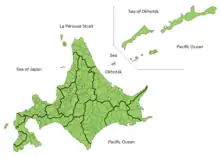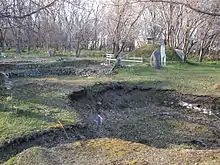Okhotsk culture
The Okhotsk culture is an archaeological coastal fishing and hunter-gatherer culture of the lands surrounding the Sea of Okhotsk and Japan. The historical Okhotsk people were related to various Northeast Asians and were one of the diverse people living during the Jōmon period in (northern) Japan. The Okhotsk are one of the ancestral components of the Ainu people and contributed the Ainu languages and significant cultural elements.[2][3] It is suggested that the bear cult, a practice shared by the Ainu and the Nivkhs, was an important element of the Okhotsk culture and may have been common in Jomon period Japan as well.[4]
 | |
| Alternative names | Proto-Ainu |
|---|---|
| Geographical range | mainly Hokkaido and the Kurils, parts of southern Sakhalin and northern Honshu |
| Followed by | Ainu culture[1] |

A study by Lee and Hasegawa of the Waseda University, concluded that the Jōmon period population consisted largely of a distinctive Paleolithic population from Central Asia and an ancient Northeast Asian population (Okhotsk people), with both arriving at different times during the Jōmon period in Japan. According to them, the direct ancestors of the later Ainu people formed from the combination of these two distinct populations during the Jōmon period in northern Hokkaido, long before the arrival of contemporary Japanese people. From there the ancestors of the Ainu-speakers expanded into large parts of Honshu and the Kurils. Lee and Hasegawa presented evidence that the Ainu language originated from the Northeast Asian/Okhotsk population, which established themselves in northern Hokkaido and had significant impact on the formation of the Jōmon culture and ethnicities. They further concluded that the "dual structure theory" regarding the population history of Japan must be revised and that the Jōmon people had more diversity than originally suggested.[5]
A distinctive trait of the Okhotsk culture was its subsistence strategy, traditionally categorised as a specialised system of marine resource gathering.[6] This is in accord with the geographic distribution of archeological sites in coastal regions and confirmed by studies of animal remains and tools, that pointed to intensive marine hunting, fishing, and gathering activities.[7] Stable nitrogen isotope studies in human remains also point to a diet with rich protein intake derived from marine organisms.[8][9][10] Collagen analysis of human bones revealed a relative contribution of marine protein in a range of 60 to 94% for individuals from Rebun Island and from 80 to 90% for individuals from eastern Hokkaido. However, there are enough evidences to suggest that the Okhotsk people's diet was much more diverse than isotopic data suggests. Their diet was probably complemented with terrestrial mammals, such as deer, foxes, rabbits, and martens. Cut marks in domesticated dog bones suggest they were also part of the diet, and remains of domestic pigs are limited to the north of Hokkaido. There is also evidence of the use of wild edible plants, including Aralia, Polygonum, Actinidia, Vitis, Sambucus, crowberry, Rubus sp., Phellodendron amurense, and Juglans. Little is known about the role of these plants in the economy or if they had dietary or ritual roles.
Kisao Ishizuki of the Sapporo University suggests that the people of the Okhotsk culture were recorded under the name Mishihase on the Japanese record Nihon Shoki,[11] while others suggest that the term Mishihase described a different group or one of the Nivkh tribes.[12]
According to Kikuchi Toshihiko from the Hokkaido University, the Okhotsk people, which were mainly based in northern Hokkaido, are direct ancestral to the Ainu and can be considered as "proto-Ainu". The Ainu ethnicity finally formed through the combination of these proto-Ainu Okhotsk and Satsumon tribes from further south. Later the Ainu rapidly expanded into Sakhalin and Kamchatka as well as northern Honshu.[13]
The Okhotsk culture appears directly ancestral to the following Ainu culture.[14]
The Okhotsk people, an ancient people of the North, formed the Okhotsk culture unique to Hokkaido from the 5th to 9th centuries. They lived as hunters who caught and ate fish from the sea, and at times caught sea creatures that drifted here along with the sea ice, as the natural bounty found in the Okhotsk Sea was indeed a heavenly blessing. Their expansive living and cultural territory is evidenced by the pit dwelling ruins excavated along the coast of the Okhotsk Sea. They left behind fascinating carvings and earthenware, while evidence suggests that they shared a common belief system with the Ainu culture such as the spiritual worship of the natural world and respect for bears as a sacred animal.
— Hokkaido Museum Abashiri
References
- Theme C: Learning about and enjoying the symbiosis between humans and nature from history. Mt. Apoi Geopark Promotion Concil, Japan
- Sato, Takehiro; Amano, Tetsuya (2007). "Origins and genetic features of the Okhotsk people, revealed by ancient mitochondrial DNA analysis". Journal of Human Genetics. 52 (7): 618–27. doi:10.1007/s10038-007-0164-z. PMID 17568987.
- Jeong, Choongwon; Nakagome, Shigeki; Rienzo, Anna Di (January 1, 2016). "Deep History of East Asian Populations Revealed Through Genetic Analysis of the Ainu". Genetics. 202 (1): 261–272. doi:10.1534/genetics.115.178673. PMC 4701090. PMID 26500257 – via www.genetics.org.
- Trekhsviatskyi, Anatolii (2007). "At the far edge of the Chinese Oikoumene: mutual relations of the indigenous population of Sakhalin with the Yuan and Ming dynasties". Journal of Asian History. 41 (2): 134–135. JSTOR 41933457.
- Lee, Hasegawa, Sean, Toshikazu (April 2013). "Evolution of the Ainu Language in Space and Time". PLOS ONE. 8 (4): e62243. Bibcode:2013PLoSO...862243L. doi:10.1371/journal.pone.0062243. PMC 3637396. PMID 23638014.
In this paper, we reconstructed spatiotemporal evolution of 19 Ainu language varieties, and the results are in strong agreement with the hypothesis that a recent population expansion of the Okhotsk people played a critical role in shaping the Ainu people and their culture. Together with the recent archaeological, biological and cultural evidence, our phylogeographic reconstruction of the Ainu language strongly suggests that the conventional dual-structure model must be refined to explain these new bodies of evidence. The case of the Ainu language origin we report here also contributes additional detail to the global pattern of language evolution, and our language phylogeny might also provide a basis for making further inferences about the cultural dynamics of the Ainu speakers [44,45].
- Hudson, Mark J. (2004). "The perverse realities of change: world system incorporation and the Okhotsk culture of Hokkaido". Journal of Anthropological Archaeology. 23 (3): 290–308. doi:10.1016/j.jaa.2004.05.002.
- Leipe, Christian; Sergusheva, Elena A.; Müller, Stefanie; Spengler, Robert N.; Goslar, Tomasz; Kato, Hirofumi; Wagner, Mayke; Weber, Andrzej W.; Tarasov, Pavel E. (2017). "Barley (Hordeum vulgare) in the Okhotsk culture (5th–10th century AD) of northern Japan and the role of cultivated plants in hunter–gatherer economies". PLOS ONE. 12 (3): e0174397. Bibcode:2017PLoSO..1274397L. doi:10.1371/journal.pone.0174397. PMC 5371317. PMID 28355249.
- Aikens, C. Melvin; Rhee, Song Nai; Circum-Pacific Prehistory Conference, eds. (1992). Pacific northeast Asia in prehistory: hunter-fisher-gatherers, farmers, and sociopolitical elites. Pullman, Wash.: WSU Press. ISBN 9780874220926. OCLC 26403218.
- Yoneda, Minoru; Ono, Hiroko; Amano, Tetsuya; Ishida, Hajime; Dodo, Yukio; Honch, Noah V.; Shibata, Yasuyuki; Mukai, Hitoshi; Ohkouchi, Naohiko (2010). "Dietary Reconstruction of the Okhotsk Culture of Hokkaido, Japan, Based on Nitrogen Composition of Amino Acids: Implications for Correction of 14C Marine Reservoir Effects on Human Bones". Radiocarbon. 52 (2): 671–681. doi:10.1017/S0033822200045690.
- Yoneda, Minoru; Ishida, Hajime; Naito, Yuichi I.; Tsutaya, Takumi (2014). "Carbon and nitrogen isotope analyses of human and dog diet in the Okhotsk culture: perspectives from the Moyoro site, Japan". Anthropological Science. 122 (2): 89–99. doi:10.1537/ase.140604.
- "第4回 北海道と胆振地方の古代史" (in Japanese). Tomakomai Komazawa University. Retrieved February 22, 2011.
- "ウェブマガジン カムイミンタラ ~北海道の風土・文化誌 :オホーツク文化人とモヨロ貝塚 網走 流氷とともにやってきた古代民族の謎とロマンに魅せられた父子三代と研究者たち". kamuimintara.net. Retrieved 2019-05-14.
- "The Ainu and Early Commerce in the Sea of Okhotsk". nippon.com. 2012-02-28. Retrieved 2020-12-16.
- "The Northern People | ROAD EAST". www.road-east.com. Retrieved 2020-12-16.
External links
- Ohyi, Haruo (1975). "The Okhotsk Culture, a Maritime Culture of the Southern Okhotsk Sea Region". In Fitzhugh, William (ed.). Prehistoric Maritime Adaptations of the Circumpolar Zone. pp. 123–58. doi:10.1515/9783110880441.123. ISBN 978-3-11-088044-1.
- Okada, Atsuko (1998). "Maritime Adaptations in Hokkaido". Arctic Anthropology. 35 (1): 340–9. JSTOR 40316474.